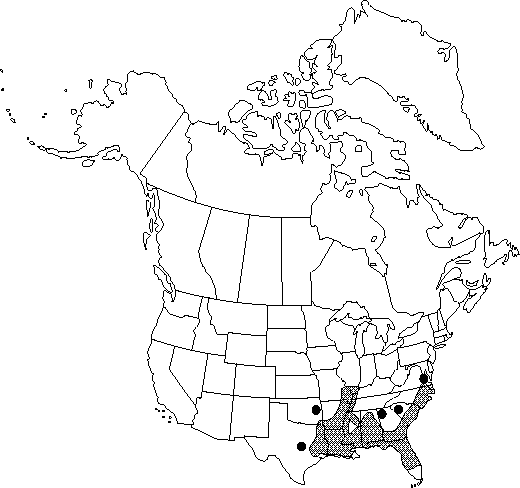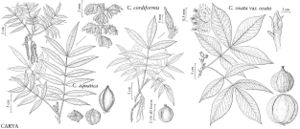Carya aquatica
Gen. N. Amer. Pl. 2: 222. 1818.
Trees, to 46 m. Bark light gray or brownish, exfoliating, separating freely into long strips or broad plates, less commonly with small platelike scales. Twigs brown to reddish-brown or black, slender, villous becoming glabrous. Terminal buds brown, reddish-brown, or black, oblong, 8-10 mm, yellow-scaly, villous; bud-scales valvate; axillary buds protected by bracteoles fused into hood. Leaves 4-6 dm; petiole 3-8 cm, villous becoming glabrous. Leaflets (5-) 9-11 (-13), lateral petiolules 0-2 mm, terminal petiolules (2-) 6-10 (-14) mm; blades ovatelanceolate, often falcate, 2-19 × 1-4 cm, margins finely or coarsely serrate to entire and wavy, without tufts of hairs, apex acuminate; surfaces abaxially villous with unicellular and 2-8-rayed fasciculate hairs along midrib and secondary-veins, densely scaly in spring with large peltate scales and small round, irregular, and 4-lobed peltate scales, adaxially villous along midrib near base, glabrous between veins. Staminate catkins pedunculate, to 21 cm, stalks villous, bracts scaly; anthers without hairs. Fruits brown, bronze, or black, obovoid, compressed, 1.5-3 × 1.5-2.5 cm; husks rough, 1 mm thick, dehiscing to base or nearly so, sutures winged; nuts chocolate brown, broadly obovoid, compressed, 2-angled, verrucose; shells thin. Seeds bitter. 2n = 32.
Phenology: Flowering spring.
Habitat: Bayous, river flood plains, bluffs, and levees, temporarily flooded bottomlands
Elevation: 0-200 m
Distribution

Ala., Ark., Fla., Ga., Ill., Ky., La., Miss., Mo., N.C., Okla., S.C., Tenn., Tex., Va.
Discussion
Carya aquatica hybridizes with C. illinoinensis (C. ×lecontei Little [= Hicoria texana Le Conte]) and is reported to hybridize with the tetraploid C. texana [C. ×ludoviciana (Ashe) Little].
Selected References
None.
